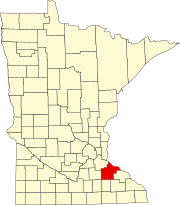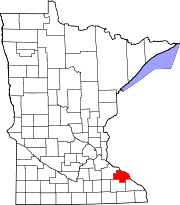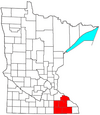Lake City, Minnesota
Lake City, Minnesota | |
|---|---|
 Location of Lake City, Minnesota | |
| Country | United States |
| State | Minnesota |
| Counties | Wabasha, Goodhue |
| Area | |
| • Total | 4.3 sq mi (11.1 km2) |
| • Land | 4.2 sq mi (11.0 km2) |
| • Water | 0.1 sq mi (0.1 km2) |
| Elevation | 696 ft (212 m) |
| Population | |
| • Total | 5,063 |
| • Density | 1,166.9/sq mi (450.6/km2) |
| Time zone | UTC-6 (Central (CST)) |
| • Summer (DST) | UTC-5 (CDT) |
| ZIP code | 55041 |
| Area code | 651 |
| FIPS code | 27-34172Template:GR |
| GNIS feature ID | 0646338Template:GR |
| Website | ci.lake-city.mn.us |



Lake City is a city in Goodhue and Wabasha counties in the U.S. state of Minnesota. It lies along Lake Pepin, a wide portion of the Mississippi River. The population was 5,063 at the 2010 census.[1] Most of Lake City lies in Wabasha County, with only a small portion of in Goodhue County.
History
The City of Lake City is located 65 miles South of the Twin Cities at the intersection of highways 61 South and 63 North right on the Mighty Mississippi River at a beautiful spot called Lake Pepin. Lac de Pleurs (Lake of Tears) was the name given to Lake Pepin by Father Louis Hennepin, who camped on the shore of the lake in 1680. He christened the large body of water Lac de Pleurs after observing his Sioux captors weeping near the lake over the death of a chief's son. The war party of Isanti Sioux had captured Hennepin and his two companions several miles south along the Mississippi and were camping near the lake on their return north to their Sioux villages near present day Mille Lacs.
The first known settler was Jacob Boody, who arrived in 1853. In the years to follow, several explorers passed through this area. The town was platted in 1855. The town supervisors were given special powers by the State Legislature in 1864 to create a port market for grain. At Lake City the waters of Lake Pepin were deep enough to allow for such a port. Soon the town became noted as a profitable market with the volume of trade for the year 1866 bringing in a little over a million and a half dollars.
The City of Lake City became incorporated in 1872 and since has continued to thrive in its location on beautiful Lake Pepin. It is widely known for its attractive surroundings and bountiful fishing for every fresh water species.
Schools
Lake City is the home of Bluffview Elementary, a K-6 public elementary school, Lincoln High School for grades 7-12 (public), and St. John's, a K-8 Lutheran School. Previously, the town also was home to a Catholic School named St. Mary's.
Library
Lake City Public Library is a public library in the town. It is a member of Southeastern Libraries Cooperating, the SE Minnesota library region.[2]
Notable people
- Randy Breuer, NBA basketball player
- John Kobs, college coach
- Ralph Samuelson, inventor of water skiing
- Laura Ingalls Wilder, author
- John Hollman, director of the Mayo Clinic Physical Therapy Doctoral program
Geography
According to the United States Census Bureau, the city has a total area of 4.3 square miles (11.1 km²), of which, 4.2 square miles (11.0 km²) of it is land and 0.1 square miles (0.2 km²) of it (1.40%) is water. U.S. Highways 61 and 63 are two of the main routes in the community.
Demographics
| Census | Pop. | Note | %± |
|---|---|---|---|
| 1880 | 2,596 | — | |
| 1890 | 2,128 | −18.0% | |
| 1900 | 2,744 | 28.9% | |
| 1910 | 3,142 | 14.5% | |
| 1920 | 2,846 | −9.4% | |
| 1930 | 3,210 | 12.8% | |
| 1940 | 3,204 | −0.2% | |
| 1950 | 3,457 | 7.9% | |
| 1960 | 3,494 | 1.1% | |
| 1970 | 3,594 | 2.9% | |
| 1980 | 4,505 | 25.3% | |
| 1990 | 4,391 | −2.5% | |
| 2000 | 4,950 | 12.7% | |
| 2010 | 5,063 | 2.3% | |
As of the censusTemplate:GR of 2000, there were 4,950 people, 2,131 households, and 1,402 families residing in the city. The population density was 1,166.9 people per square mile (450.8/km²). There were 2,347 housing units at an average density of 553.3 per square mile (213.7/km²). The racial makeup of the city was 96.81% White, 0.63% African American, 0.40% Native American, 1.11% Asian, 0.28% from other races, and 0.77% from two or more races. Hispanic or Latino of any race were 2.22% of the population.
There were 2,131 households out of which 26.7% had children under the age of 18 living with them, 56.0% were married couples living together, 7.4% had a female householder with no husband present, and 34.2% were non-families. 29.2% of all households were made up of individuals and 14.7% had someone living alone who was 65 years of age or older. The average household size was 2.30 and the average family size was 2.83.
In the city the population was spread out with 22.8% under the age of 18, 6.4% from 18 to 24, 26.1% from 25 to 44, 24.8% from 45 to 64, and 19.9% who were 65 years of age or older. The median age was 41 years. For every 100 females there were 93.1 males. For every 100 females age 18 and over, there were 89.9 males.
The median income for a household in the city was $40,637, and the median income for a family was $47,146. Males had a median income of $35,321 versus $24,799 for females. The per capita income for the city was $20,944. About 3.2% of families and 6.0% of the population were below the poverty line, including 7.7% of those under age 18 and 5.1% of those age 65 or over.
References
- ^ a b "2010 Census Redistricting Data (Public Law 94-171) Summary File". American FactFinder. United States Census Bureau. Retrieved 27 April 2011.
- ^ Southeastern Libraries Cooperating (SELCO)



